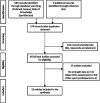Normative values for internal and external glenohumeral rotation strength in rugby players: A systematic review with meta-analysis
- PMID: 38425741
- PMCID: PMC10901170
- DOI: 10.1177/17585732221098738
Normative values for internal and external glenohumeral rotation strength in rugby players: A systematic review with meta-analysis
Abstract
This systematic review aims to provide normative values for internal and external glenohumeral rotation strength in rugby players. From the inception to March 2021, the search strategy was (strength OR torque) AND shoulder AND rugby using PubMed, Scopus, Web of Science, and SPORTDiscus databases, with no language restrictions. This systematic review includes 15 articles involving 573 rugby players and presenting internal or external glenohumeral rotation strength values. Two main methods are used to assess glenohumeral rotation strength in rugby players: isokinetic and isometric methods; in the isometric method, the upper arm is abducted at either 0° or 90°. Owing to differences in isokinetic procedures and a lack of studies assessing isometric strength when the upper arm is in a neutral position, normative internal or external glenohumeral rotation strength values are only provided for isometric contractions when the upper arm is abducted at 90° based on 311 shoulders of 163 male rugby union players, with 2.04 ± 0.15 N.kg-1 and 2.11 ± 0.13 N.kg-1 for internal and external glenohumeral rotation strength, respectively. These findings may help strength and conditioning coaches and physical therapists, provide objective evidence when deciding whether or not rugby union players should return to sport.
Keywords: collision sports; isokinetic assessment; isometric assessment; shoulder.
© The Author(s) 2022.
Conflict of interest statement
The author(s) declared no potential conflicts of interest with respect to the research, authorship, and/or publication of this article.
Figures


Similar articles
-
Upper Extremity Musculoskeletal Profiles in Tennis Players: A Systematic Review.Sports Health. 2024 Nov-Dec;16(6):931-937. doi: 10.1177/19417381231223540. Epub 2024 Feb 15. Sports Health. 2024. PMID: 38361439 Free PMC article.
-
Minimally Invasive Subscapularis Release for Internal Rotation Contracture of the Shoulder in Residual Brachial Plexus Birth Injury.JBJS Essent Surg Tech. 2025 Jun 25;15(2):e24.00008. doi: 10.2106/JBJS.ST.24.00008. eCollection 2025 Apr-Jun. JBJS Essent Surg Tech. 2025. PMID: 40567510 Free PMC article.
-
Movement Patterns and Muscular Function Before and After Onset of Sports-Related Groin Pain: A Systematic Review with Meta-analysis.Sports Med. 2016 Dec;46(12):1847-1867. doi: 10.1007/s40279-016-0523-z. Sports Med. 2016. PMID: 27142535 Free PMC article.
-
Glenohumeral Internal Rotation Deficit and Risk of Upper Extremity Injury in Overhead Athletes: A Meta-Analysis and Systematic Review.Sports Health. 2018 Mar/Apr;10(2):125-132. doi: 10.1177/1941738118756577. Epub 2018 Jan 30. Sports Health. 2018. PMID: 29381423 Free PMC article.
-
Relationship Between Shoulder Rotation Strength and Upper Extremity Functional Assessments in Collegiate Baseball Players.J Funct Morphol Kinesiol. 2025 Apr 3;10(2):120. doi: 10.3390/jfmk10020120. J Funct Morphol Kinesiol. 2025. PMID: 40566417 Free PMC article.
References
-
- Bohu Y, Klouche S, Lefevre N, et al. The epidemiology of 1345 shoulder dislocations and subluxations in French rugby union players: a five-season prospective study from 2008 to 2013. Brit J Sports Med 2015; 49: 1535–1540. - PubMed
-
- Funk L, Walton M, Watts A, et al. Sports injuries of the shoulder. Switzerland: Springer Nature, 2020.
Publication types
LinkOut - more resources
Full Text Sources
